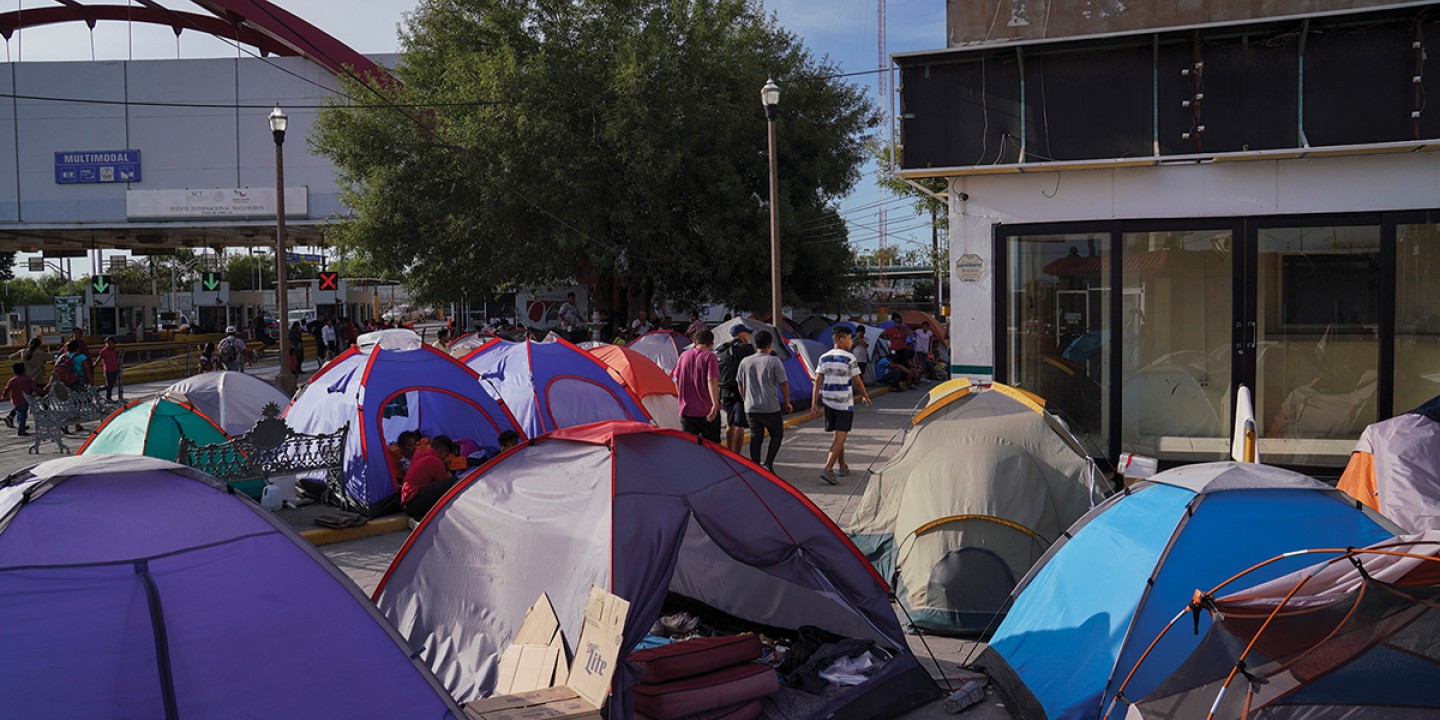Visiting a tent city in Mexico created by Trump’s Migrant Protection Protocol
The children here are gaunt and listless. They are running out of time.

I am standing underneath the only shade tree in sight, the first one you get to once you cross the border, a stone’s throw from the international bridge that spans the Rio Grande between Brownsville, Texas, and Matamoros, Mexico. Nobody in south Texas stands outside at three o’clock in the afternoon in August, not even under a shade tree. But here in Matamoros, this tree’s shade is home to a whole village: a tent city planted by the streams of concrete, hundreds of migrants who have fled violence and persecution only to wind up here, unable to cross the bridge and unable to return home, with only one good shade tree for protection.
My Spanish is limited, but through an interpreter, I hear their stories. One family has come from El Salvador, another from the Dominican Republic, another from Guatemala. None of them has come seeking fame and fortune—only safety. A mother watched her son die at the hands of a drug cartel; she came north with her remaining children. A father brought his family after refusing to pay protection fees to the local mob. I have been instructed not to post any photographs on social media that could aid any cartel hoping to track any of these folks down. All of them are in danger, and none of them can go home.
Read our latest issue or browse back issues.
They can’t stay here either, at least not indefinitely. Cartels are also at the border, preying on anyone who shows up with cash or valuables and extorting extravagant fees for desperate trips across the river. Whatever money these families had when they left home has been fully depleted. Now they can’t even afford the pay toilet inside the Mexican border office. Instead, the river itself has become bath, toilet, and drinking fountain. As a result, many of the children show visible skin lesions and rashes, and none of the parents has access to medication or treatment.
I think of my own eight-year-old son, so full of life and vitality. The children here are gaunt and listless. They are running out of time—and yet they wait, another six, eight, or ten weeks, until their appointed date with the asylum system. Many have been here for several months already.
For me, the afternoon grows short. I have come across the bridge with a hundred Texas clergy for a weekend of intense on-site education hosted by Texas Impact, a statewide interfaith advocacy network—and we have a bus waiting for us. We flash our passports to the agents at the boundary line, quickly leapfrogging the hundreds of others waiting their turn. We all look a little bit worse for the wear—a little weary from the afternoon, a bit beaten down by the hot sun. I was there for an hour, and it almost did me in.
What lingers with me later is how needless the situation is. On the streets of Austin, my home city, chronic homelessness creates enclaves similar to the one across the border in Matamoros. But chronic homelessness is a complicated problem measured in generational causes. This particular tent city has one cause, which is the US government’s decision earlier this year to prevent migrants from making a legal asylum claim—the so-called Migrant Protection Protocols, otherwise known as Remain in Mexico.
A year ago, any of these migrants could have walked across the bridge, presented themselves to a border agent, claimed asylum, and been whisked away to one of the American detention centers where we have—somewhat infamously—held all those waiting to make their case in an immigration court. Today, however, two agents are standing exactly on the border line, preventing anybody without papers from getting one centimeter’s worth of physical access to the United States and thereby eliminating the possibility of receiving asylees or following anything resembling humanitarian due process.
The result is this tent city, the most vulnerable population I have ever seen. The stories coming out of our detention centers over the past year have ranged from depressing to savage to inhuman. But to a person, everyone I met in that tent city would have gladly chosen detention instead of huddling underneath that tree. At least, they told me, there would be water, and protection, and shade enough for everybody.
When I tell friends and colleagues about this trip, they ask, What can we do? How can we help? Where can we send money? The good news is that there are organizations on the ground committed to alleviating the material suffering in the tent city as much as possible. Here’s my favorite: every day, a member of a ragtag group of women in the Rio Grande Valley brings food across the border. They bring breakfast tacos when the money is good, peanut butter sandwiches when it’s not. They call themselves the Angry Tias and Abuelas, and you can go to their website and donate right now.
But the truth is that this crisis will not get fixed by a humanitarian response. No quantity of breakfast tacos can make this go away. It is a crisis of public policy. It is the direct consequence of the horribly named Migrant Protection Protocols, which do nothing for migrants except leave them in the most vulnerable situation imaginable and which protect nothing except for the public image of detention centers where overcrowding issues are slowly evaporating. The MPP, of course, sit on top of a whole history of American attitudes about immigration, race, and national exceptionalism—it’s complicated. But it’s also simple. This is a crisis of bad, immoral policy, full stop.
Churches don’t always know how to talk about public policy. We are much better at sending breakfast tacos, and the stretch from the one response to the other isn’t always comfortable. But a crisis of bad, immoral policy requires moral leadership and moral imagination of the sort that the church is uniquely called to provide. So when I got home from the border, I did the most theologically informed, morally grounded, and steadfastly faithful act of discipleship I could think of: I called my congressman.
A version of this article appears in the print edition under the title “Unprotected migrants.”






